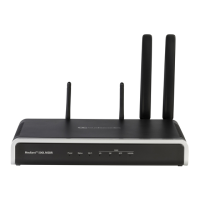User's Manual 540 Document #: LTRT-10466
Mediant 500L MSBR
31.9.1 Initiating SIP Call Forking
The SBC device supports call forking of an incoming call to multiple SBC users
(destinations). Call forking is supported by the device's capability of registering multiple SIP
client user phone contacts (mobile and fixed-line extensions) under the same Address of
Record (AOR) in its registration database. This feature can be implemented in the following
example scenarios:
An enterprise Help Desk, where incoming customer calls are simultaneously sent to
multiple customer service agent extensions.
An employee's phone devices, where the incoming call is simultaneously sent to
multiple devices (e.g., to the employee's office phone and mobile SIP phone).
An enterprise reception desk, where an incoming call is simultaneously sent to
multiple receptionists.
The device supports various modes of call forking. For example, in Parallel call forking
mode, the device sends the INVITE message simultaneously to all the users registered
under the same AOR, resulting in the ringing of all extensions; the first extension to pick up
the call receives the call, and all other extensions stop ringing. The Call Forking feature is
configured by creating a User-type IP Group and configuring the IP Group table's
parameter, 'SBC Client Forking Mode' (see ''Configuring IP Groups'' on page 287).
The device can also fork INVITE messages received for a Request-URI of a specific
contact (user), belonging to the destination IP Group User-type, registered in the database
to all other users located under the same AOR as the specific contact. This is configured
using the SBCSendInviteToAllContacts parameter.

